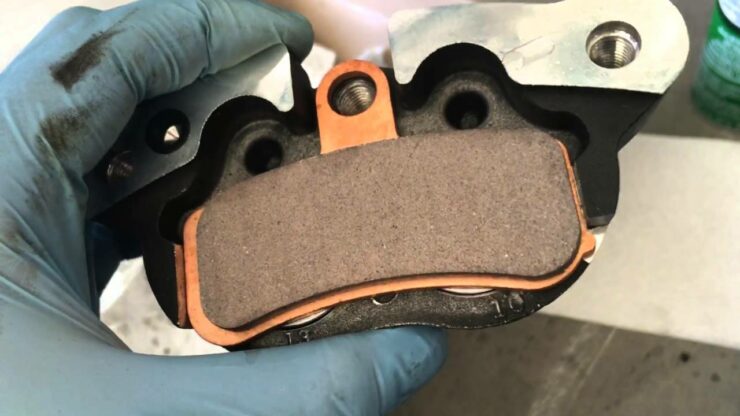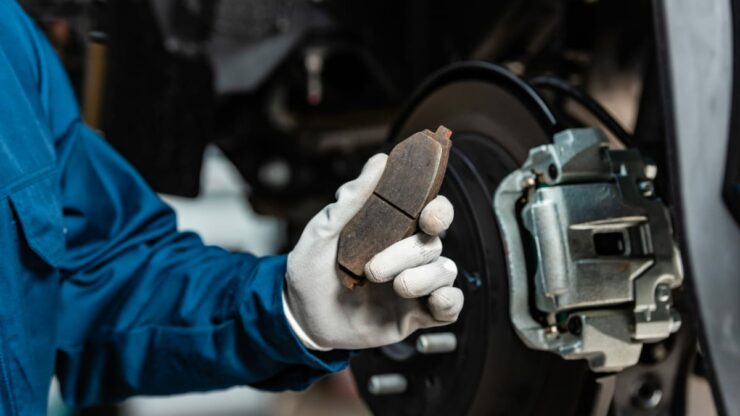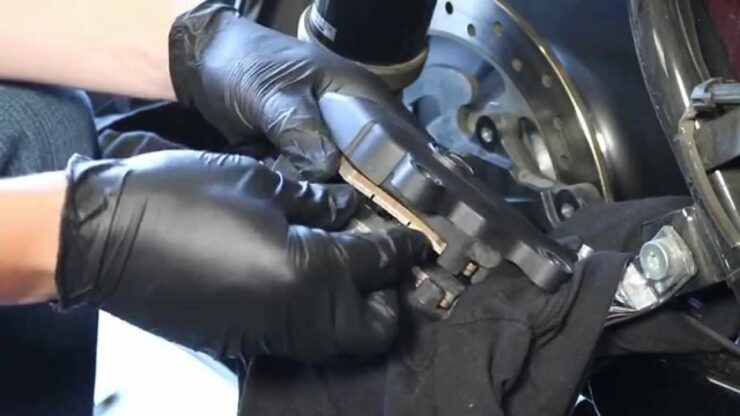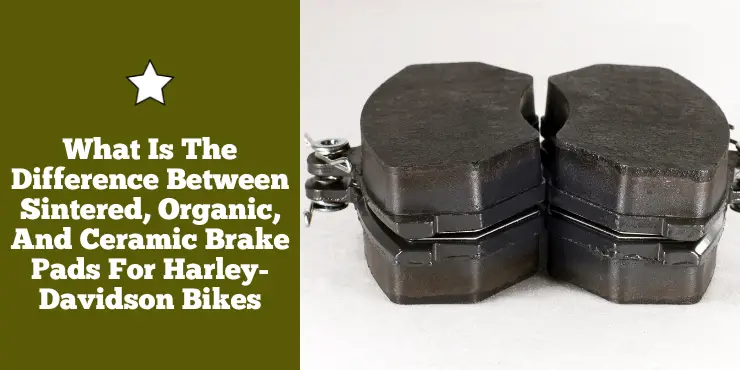Are you a Harley-Davidson enthusiast looking to upgrade your bike’s braking system? If so, you’ve probably come across different types of brake pads, such as sintered, organic, and ceramic. But what exactly are the differences between these options, and which one is the best for your ride?
Sintered pads offer excellent durability and heat resistance for heavy-duty use, organic pads provide smoother, quieter braking with less wear on rotors, and ceramic pads deliver strong stopping power and minimal dust production, ideal for performance-oriented riders.
In this article, we’ll dive into the world of brake pads and take a closer look at the characteristics and benefits of sintered, organic, and ceramic brake pads for Harley-Davidson bikes. By the end, you’ll have a clear understanding of which type suits your needs and can confidently make an informed decision. So, let’s get started and explore the fascinating realm of brake pads for your beloved Harley-Davidson!
Role of brake pads in Harley-Davidson bikes
Harley-Davidson is celebrated for producing powerful and distinctive bikes that have become icons of the open road. As you’re cruising down the highway, enjoying the freedom that only a Harley-Davidson is capable of providing, it is easy to overlook the role brake pads play in ensuring your control and safety.
>>> Click here to read our review of the Best Break Pads For Harley-Davidson <<<
Brake pads are critical components in the braking system of your Harley-Davidson bike. They are responsible for converting kinetic energy into thermal energy to slow down and stop the vehicle. In the case of Harley-Davidson bikes, brake pads are the linings that press against the brake discs when the brake lever or pedal is applied. The resulting friction generates the force needed for decelerating and halting the bike.
Here is the role brake pads play in the functioning of a Harley-Davidson bike –
#1. Provide safety and control
The primary role of brake pads in Harley-Davidson bikes is to provide the needed safety and control to the rider. The brake system’s effectiveness will largely depend on the friction generated by the brake pads. When you squeeze the brake lever, the pads grip the brake discs, creating the needed resistance to slow down and stop the bike. This essential function will ensure that you can navigate your Harley-Davidson bike with confidence, irrespective of your riding style or road conditions.
#2. Stopping power
Harley-Davidson bikes are known for their powerful engines. With great power also comes the need for equally impressive stopping power. Brake pads are responsible for providing the needed friction to bring a heavy, high-performance bike to a complete stop, even when traveling at high speeds. Without brake pads, riders will be unable to harness the full potential of their bikes or enjoy a safe riding experience.
#3. Precision and responsiveness
In a world full of unpredictable road conditions, Harley-Davidson riders need the ability to control their bikes with precision and responsiveness. Brake pads deliver this capability, allowing riders to modulate their speed and respond swiftly to sudden obstacles, changing weather conditions, or other unforeseen challenges.
#4. Durability and peace of mind
Harley-Davidson bikes are known for their longevity and this quality will extend to the brake pads too. High-quality brake pads are engineered to withstand the intense heat generated during frequent braking, ensuring durability and peace of mind throughout extended rides. This durability will guarantee that riders are able to rely on their brakes even during long, demanding journeys.
#5. Maintain optimal performance
Like all motorcycle components, brake pads require regular maintenance and, eventually, replacement. Over time, the constant friction will result in wear and tear. Neglecting to replace worn-out brake pads can result in a decline in braking efficiency, which isn’t just frustrating but also potentially dangerous.

#6. Customization for different models
Harley-Davidson produces a diverse range of models, each with its unique features and characteristics. To cater to these variations, the company offers a wide range of brake pads tailored to the specific requirements of different models. This will ensure that riders can enjoy optimal braking performance that matches the performance and weight distribution of their specific Harley-Davidson model.
Factors to consider when choosing brake pads for your Harley-Davidson bike
Harley-Davidson are known for their style, power, and speed. When you are driving a powerful at such high speeds, ensuring your safety will be paramount. One of the elements that contribute to rider safety will be the brake system. When it comes to choosing the right brake pads for your bike, there are certain factors you must consider. Here are some of the factors you must consider when choosing brake pads for your Harley-Davidson bike –
#1. Riding style
You must consider your personal riding style when choosing brake pads. Are you a spirited tourer, a leisurely cruiser, or an aggressive rider? Each style will demand different brake pad characteristics. Sportier riders will likely prioritize stopping power and might lean toward semi-metallic pads whereas cruisers might prioritize the quiet and smooth braking provided by organic pads.
#2. Bike model and weight
Harley-Davidson is a brand that manufactures a wide range of bikes, each with unique characteristics and weight distribution. It is important to select brake pads that are compatible with your specific Harley model. The weight of your motorcycle plays a key role in the braking system’s effectiveness, so ensure that you’re choosing brake pads that can handle your bike’s size and power.
#3. Weather conditions
Consider the weather conditions in which you ride primarily. If you frequently ride in wet or rainy environments, you will want brake pads that provide consistent stopping power even in adverse conditions. Ceramic or semi-metallic brake pads are usually better choices for wet weather.
#4. Brake pad life
The longevity of brake pads will be a key factor that you must take into account. Some riders prefer brake pads that last a long time to minimize maintenance whereas others prioritize peak performance and do not mind more frequent replacements. Keep in mind that the lifespan of your brake pads will depend on your riding habits and the terrain you cover.
#5. Brand and quality
Choosing a reputable brand and high-quality brake pads will be important. Harley-Davidson produces its line of brake pads designed for meeting the specific needs of its bikes. While they are often a great choice, there are also aftermarket options available. When considering aftermarket brake pads, you must research and read reviews to make sure that you are selecting a trusted brand known for producing reliable products.
#6. Budget
Lastly, your budget will be another important factor to consider. High-performance, long-lasting brake pads might come at a higher price but investing in your safety and the longevity of your bike will be well worth it. Weigh your options and select brake pads that strike a balance between your budget and performance expectations.
Sintered brake pads for Harley-Davidson motorcycles
When you are riding a Harley-Davidson bike, the braking system will be an important component for safety and controlled riding. One of the components that play a big role in the braking performance of your bike will be the type of brake pads you’re going for. Sintered brake pads are among the most commonly preferred brake pad options.
Sintered brake pads are constructed using metallic particles and additives that are fused together at high temperatures and pressures, creating a durable and heat-resistant brake pad. Sintered brake pads are designed for riders who are looking for uncompromising stopping power, especially in high-performance situations.
Here are some of the benefits of sintered brake pads for Harley-Davidson bikes –
#1. Outstanding stopping power
Sintered brake pads are known for their exceptional stopping power. They offer a level of braking performance that is well-suited for high-performance bikes like Harley-Davidson motorcycles. This brake pad will ensure that you are able to confidently and swiftly decelerate or come to a halt, even when riding at high speeds.
#2. Durability and longevity
Sintered brake pads are built to be able to withstand the demands of frequent and aggressive braking. They exhibit a longer lifespan compared to other types of brake pads, reducing the frequency of replacements. This does not just save you time and effort but also minimizes maintenance costs.
#3. Heat resistance
Another key advantage of sintered brake pads is amazing heat resistance. They perform well under high-stress conditions, such as demanding terrains or spirited riding, without a significant decline in performance. This heat resistance will ensure that the brakes remain effective even during intense braking scenarios.
#4. Versatility
Sintered brake pads are extremely versatile and well-suited for a wide variety of riding styles and terrains. Whether you are a leisurely cruiser or an adventurous road warrior, sintered brake pads can deliver the consistent stopping power you need.
Here are some of the drawbacks of sintered brake pads for Harley-Davidson bikes –

#1. Noise and vibration
One of the drawbacks of sintered brake pads is the noise and vibration they generate. Due to their metallic composition and aggressive friction, these brake pads might produce a noticeable squealing sound during braking. This can be a cause of annoyance for some riders, especially those who prefer a quiet and serene riding experience.
#2. Brake dust
Sintered brake pads tend to generate more brake dust in comparison to other types of brake pads. The excess brake dust might accumulate on your wheels and other parts of the bike, needing more frequent cleaning and maintenance to keep your Harley-Davidson bike looking its best.
#3. Brake rotor wear
The aggressive friction of sintered brake pads can result in more wear on the brake rotors over time. While this does not necessarily impact the safety or performance of your braking system, it might require more frequent brake rotor replacement.
#4. Overkill for some riders
Sintered brake pads might be seen as overkill for riders who do not regularly engage in high-speed or demanding riding. If your riding style is more relaxed or you use your Harley-Davidson bike for leisurely cruising, you might not fully benefit from the aggressive stopping power of sintered pads.
Organic brake pads for Harley-Davidson motorcycles
Organic brake pads are another popular option for Harley-Davidson bikers looking to buy brake pads for their bikes. These brake pads come with distinct advantages and disadvantages that make them unique in their own way.
Organic brake pads consist of a mixture of materials like rubber, carbon, resin, and glass, which are typically bonded together under pressure and temperature. Organic brake pads, also known as non-metallic brake pads, provide a unique set of advantages and disadvantages.
Here are some of the benefits of organic brake pads for Harley-Davidson bikes –
#1. Smooth and quiet braking
One of the standout benefits of organic brake pads is their smooth and quiet braking performance. These brake pads are engineered to provide a serene and comfortable riding experience, making them perfect for riders who prioritize a noise-free and peaceful journey.
#2. Low brake dust
Organic brake pads generate minimal brake dust, which helps keep your bike cleaner and reduces the frequency of cleaning and maintenance. This is especially appealing to riders who want to maintain the aesthetic appeal of their Harley-Davidson without constant upkeep.
#3. Gentle on brake rotors
Organic brake pads happen to be less abrasive on brake rotors, potentially extending the lifespan of this key component. This can result in cost savings over time as you replace brake rotors less frequently.
Here are some of the drawbacks of organic brake pads for Harley-Davidson bikes –
#1. Lower heat resistance
One of the major drawbacks of organic brake pads is their lower resistance to heat. Under heavy or frequent braking, these brake pads might lose efficiency and exhibit reduced stopping power due to heat-induced fading. This makes them less ideal for high-performance or demanding riding conditions.
#2. Limited stopping power
While organic brake pads offer smooth and quiet braking, they might not deliver the same level of stopping power as sintered brake pads, especially in high-stress situations. Riders looking for aggressive stopping performance might find organic pads lacking in this department.
#3. Faster wear and replacement
Organic brake pads tend to wear out more quickly compared to sintered or ceramic alternatives. Frequent replacements might be necessary, which can increase maintenance costs and the time needed for brake pad changes.
Ceramic brake pads for Harley-Davidson motorcycles
Ceramic brake pads are also a great option for Harley-Davidson riders. These brake pads seamlessly fit into the braking system of your bike. They come with a bunch of benefits and drawbacks, so you’ll need to check the situation before installing ceramic brake pads on your bike.
Ceramic brake pads are composed of ceramic fibers, filler materials, and bonding agents. These brake pads are known for their consistent and reliable braking performance.
Here are some of the benefits of ceramic brake pads for Harley-Davidson bikes –
#1. Consistent performance
Ceramic brake pads are celebrated for offering consistent and stable braking performance. Whether you are riding in dry or wet conditions, these pads maintain their effectiveness, ensuring predictable and reliable stopping power.
#2. Low noise and vibration
Another notable advantage of ceramic brake pads is their quiet operation. They generate minimal noise and vibration during braking, offering a serene and peaceful riding experience, which makes riders appreciate.
#3. Minimal brake dust
Ceramic brake pads produce little brake dust, helping keep your motorcycle cleaner and reducing the need for frequent cleaning and maintenance. This is especially appealing to riders who want to maintain their bike’s aesthetic appeal.
#4. Longevity
Ceramic brake pads often come with a longer lifespan compared to organic alternatives. This extended lifespan can result in cost savings over time as you have to replace them less frequently.
Here are some of the drawbacks of ceramic brake pads for Harley-Davidson bikes –
#1. Higher initial cost
One of the main drawbacks of ceramic brake pads is their higher upfront cost compared to organic brake pads. While the initial investment might be higher, the extended lifespan and reduced maintenance requirements can offset the initial expense.
#2. Less aggressive stopping power
Some riders might find that ceramic pads offer less aggressive stopping power compared to sintered brake pads, especially in high-stress situations. This can be a particular drawback for bikers who prioritize aggressive braking performance.
#3. Not suited for high-performance riding
While ceramic brake pads offer consistent braking performance, they might not be the best option for riders who frequently engage in high-performance riding. They might not offer the extreme stopping power required for such conditions.
#4. Heat dissipation
Ceramic brake pads are less effective at dissipating heat compared to sintered alternatives. Under prolonged, demanding braking scenarios, ceramic pads can experience heat buildup and reduced effectiveness.
What is the difference between sintered, organic, and ceramic brake pads for Harley-Davidson bikes?
When it comes to ensuring safety and control while riding your Harley-Davidson bike, choosing the right brake pads will be vital. There are three different types of brake pads that are commonly used by Harley-Davidson riders – sintered, organic, and ceramic brake pads. Each of these types of brake pads cater to different needs and preferences of the riders. This is where you might wonder what is the difference between sintered, organic, and ceramic brake pads for Harley-Davidson bikes. Here are the differences between these types of brake pads –
#1. Material composition
Sintered brake pads are made by fusing metallic particles and additives together at high temperatures and pressures. This results in a brake pad that is heat-resistant and highly durable, which is ideal for high-performance applications.
Organic brake pads are crafted from a mixture of materials like carbon, rubber, glass, and resin, bonded under pressure and temperature. They are known for their gentleness on brake rotors.
Meanwhile, ceramic brake pads are manufactured from ceramic fibers, filler materials, and bonding agents, which offer consistent and stable braking performance, as well as a low level of noise and dust generation.

#2. Performance
Sintered brake pads are known for their exceptional stopping power, making them a great option for high-performance motorcycles like Harley-Davidson bikes. They are capable of delivering a longer lifespan compared to other types, reducing maintenance and replacement costs. Moreover, these brake pads excel under high-stress conditions, maintaining their effectiveness even during intense braking.
While offering smooth and quiet braking, organic brake pads might not deliver the same level of stopping power as sintered brake pads, especially under high-stress conditions. Organic brake pads tend to wear out more quickly, necessitating more frequent replacements. Moreover, they might lose efficiency under heavy or frequent braking, especially in high-temperature scenarios.
Ceramic brake pads offer consistent and stable braking performance. However, some riders might find them slightly less aggressive in terms of stopping power, especially during high-stress situations. These brake pads often have a longer lifespan compared to organic brake pads, resulting in cost savings over time. Further, they are also less effective at dissipating heat compared to sintered alternatives, potentially experiencing heat buildup under prolonged, demanding braking scenarios.
#3. Riding style suitability
Sintered brake pads are ideal for high-performance and aggressive riding styles, spirited riders, and heavy bikes. Organic brake pads are suited for relaxed or cruising-style riding, or riders who prioritize noise reduction and minimal brake dust. Ceramic brake pads are ideal for different riding styles, including daily commuting, touring, and those looking for a consistent, low-noise, and low-maintenance braking experience.
#4. Cost considerations
Sintered brake pads might have a higher initial cost but the extended lifespan and reduced maintenance requirements could offset the initial investment. Organic brake pads tend to be more budget-friendly initially but they have a shorter lifespan, resulting in higher maintenance costs over time. Meanwhile, ceramic brake pads tend to be generally more expensive than organic alternatives but the extended longevity and reduced maintenance make them a cost-effective option in the long run.
FAQs
What are sintered brake pads for Harley-Davidson bikes?
Sintered brake pads for Harley-Davidson bikes are made by compressing metallic particles under high pressure and temperature. This process creates a dense and durable brake pad that offers excellent stopping power and heat dissipation. Sintered brake pads are known for their longevity, making them a popular choice for riders who want brakes that can withstand aggressive riding conditions.
What are organic brake pads for Harley-Davidson bikes?
Organic brake pads for Harley-Davidson bikes are made from a mixture of materials such as rubber, glass, and Kevlar fibers. These brake pads offer a quiet and smooth braking experience, making them ideal for riders who prioritize comfort and noise reduction. While organic brake pads may wear down more quickly compared to sintered or ceramic options, they tend to be gentler on the braking system and are generally considered environmentally friendly.
What are ceramic brake pads for Harley-Davidson bikes?
Ceramic brake pads for Harley-Davidson bikes are composed of a ceramic compound blended with copper fibers and other friction materials. These brake pads provide outstanding braking performance and are known for their ability to dissipate heat effectively, preventing brake fade. Ceramic brake pads are often favored by riders who engage in track or high-performance riding due to their exceptional stopping power and durability. They also produce less noise and dust compared to organic or sintered brake pads.
>>> Read more about Break Pads For Harley-Davidson <<<

